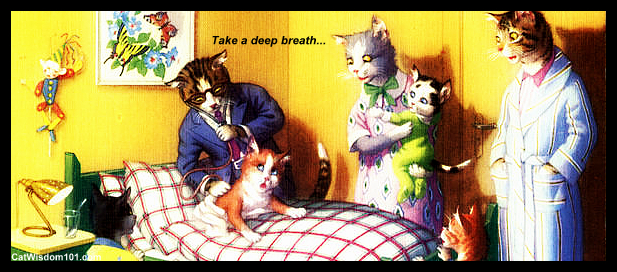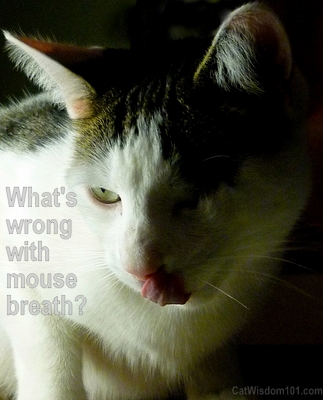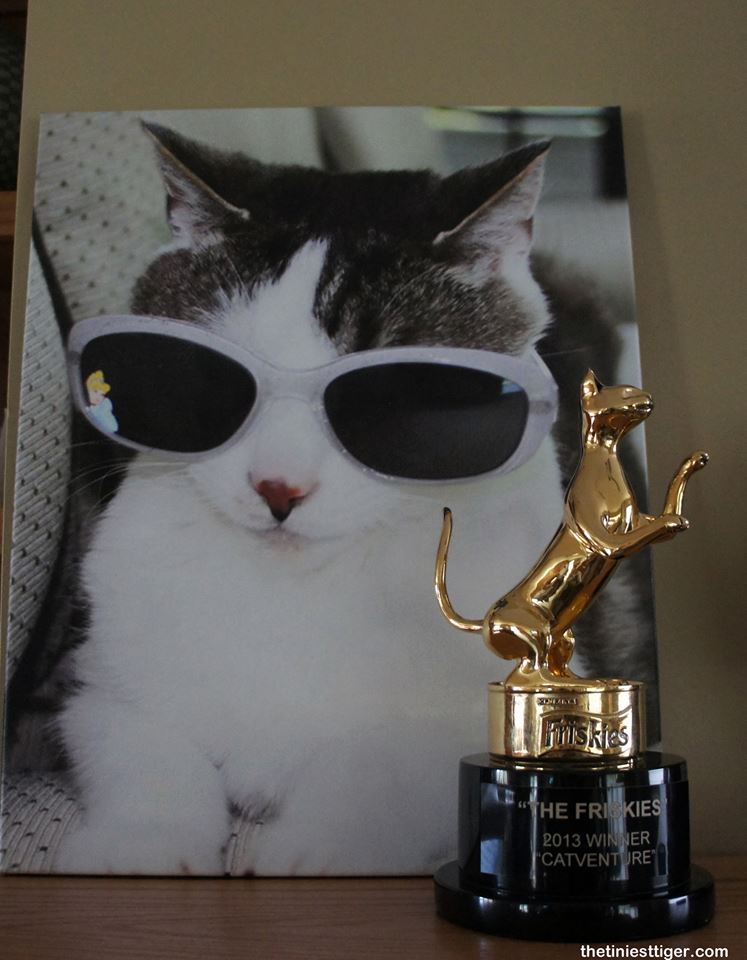Causes, Signs and Treatment for Feline Respiratory Distress

Feline Respiratory Distress, a guest post by registered vet tech, Georgia Barbush.
While some symptoms and clinical signs can be given time to resolve before seeking veterinary care, there are certain signs that warrant immediate medical attention. Respiratory distress, or dyspnea, is one of these critical conditions. Cats can be particularly guarded about showing signs of illness, so owners must be especially observant.
Signs of Feline Respiratory Distress
– Open mouth breathing: Cats are obligate nose breathers. This means it is abnormal for a cat to breath or pant through his or her mouth.
– Blue gums: This condition, called cyanosis, results from a lack of oxygen in the blood. It is important to note that serious respiratory distress may be present even if gums are pink.
– Rapid breathing or slow, labored breathing: The normal respiratory rate for a cat at rest is 20-30 breaths per minute.
– Exercise intolerance: Affected cats will experience fatigue after very short periods of activity.
– Coughing/Wheezing
– Nasal discharge
– Sitting with elbows pointed away from the body and/or the head extended downward and outward.
– Apnea: This is a complete lack of breath and a most critical emergency.
Causes of Feline Respiratory Distress
While there are many possible causes of respiratory distress in cats, some of the most common include:
– Respiratory infections
– Asthma: This condition is particularly common in cats and tends to be more severe in the spring and summer months.
– Trauma/Injury: May result from an animal attack, fall, puncture wound, etc.
– Heart or lung disease
– Obstruction: Caused by foreign bodies or internal masses in the air passages.
– Electrical shock
– Exposure to smoke or toxins
– Heat stroke or heat exhaustion
What to Do If Your Cat Has Trouble Breathing
If you suspect your cat is experiencing respiratory distress, contact your veterinarian or critical care hospital immediately. They will be able to assess your cat’s specific symptoms and provide the best advice for home care or care during transport to the hospital. In cases of respiratory distress it is especially important to minimize stress as much as possible. This can be quite difficult when transporting an already compromised cat, but keeping things as calm, quiet, and gentle as possible will help.
If your cat has stopped breathing before reaching the hospital, you can perform CPR. Your veterinarian will be able to give you specific CPR instructions over the phone. To help prepare for emergencies before they occur, pet first aid and CPR classes are available in many areas.

What Will Happen at the Hospital
Your veterinarian will have to find the balance between relieving the dyspnea and determining its cause. Stress will only exacerbate respiratory distress and can result in respiratory arrest. In moderate to severe cases of dyspnea, diagnostic testing and even a physical exam may be too stressful initially. These cats will need to spend time in an oxygen cage under constant, close observation until they are able to breathe more easily. If the patient is not breathing, a tube will be placed in the airway so that oxygen may be administered. Emergency drugs may also be administered to stimulate respiration and cardiac activity.
The ICU Cage is a controlled oxygen therapy unit that can be used for home use. An oxygen tent can be beneficial to cats with chronic respiratory difficulty, as long as they are not so stressed inside the tent that it negates the benefits of the oxygen therapy. It may also be possible to have a small oxygen tank setup at home so oxygen can be administered via the “blow by” technique, where the tube is held in the vicinity of the cat’s face, but not so close as to cause discomfort or stress. Some cats prefer this to being confined in a tent or kennel.
Preventing Feline Respiratory Distress
There are a number of ways to limit your cat’s risk of developing respiratory distress:
– Consult your veterinarian right away if your cat shows signs of a respiratory infection (mainly repeated sneezing, nasal discharge, ocular discharge, and ulcers on the tongue)
– Keep potentially toxic substances safely stored away
– Provide cool areas and plenty of water in hot weather
– Keep electrical cords out of reach or covered with protective tubing
– Schedule veterinary check-ups at least once per year
– Minimize potential stressors and provide cats with a safe, quiet retreat of their own




12 Comments
Martin Johnsan
Thanks for sharing the information about respiratory distress.
Austin Towers
A very good post to bookmark! Thank you Layla!
Katnip Lounge
Gosh, I had this up close and purrsonal last week with John! Thankfully, he’s doing MUCH better today…great post!
Sue Brandes
Hugs and purrs to Abby. Sorry for your loss. Thank you for the information Layla.
Fur Everywhere
Thank you for the great information! I suggested to our service coordinators that we have a class on pet first aid and CPR since so many of us have pets in the complex. But if they don’t have one soon, I’ll look to see if I can take one somewhere else. I like being as prepared as I can for emergencies if they should happen.
Alana Grelyak & Crepes
Thanks for the info, Layla! Good to know the signs and be reminded of them, just in case.
Abby
Layla
Painfully near to my heart.
All of what you’ve shared is right on the mark.
That was the O2 tent we got for my beloved girl. Sadly she only used it for a mere 3 hours before she was gone. It is well made and if any kitty just needs at home O2 I would highly recommend the Buster ICU cage. Now her Buster will help benefit other animals as we donated it to our local vet which did not have the O2 tent. It was Abby’s way of paying it forward and hope it helps some other kitty or doggie.
Layla Morgan Wilde
Sorry for the odd coincidence of topic. Thanks for sharing about the ICU and bless you for paying it forward. Sending continued hugs and purrs your way.
da tabbies o trout towne
grate post guys….hope everee one iz havin a ton oh trout thurzday 🙂
Kathryn
Oh my, excellent words and I will keep this handy, after you know what last year.
Ann Paws
Wonderful post! Our cat, Kitty Kitty Meow Meow had some respiratory issues during one summer – open mouth breathing. She was diagnosed with asthma, although she never had the issues after that summer thankfully.
Layla Morgan Wilde
Thanks Ann for sharing about you cat.